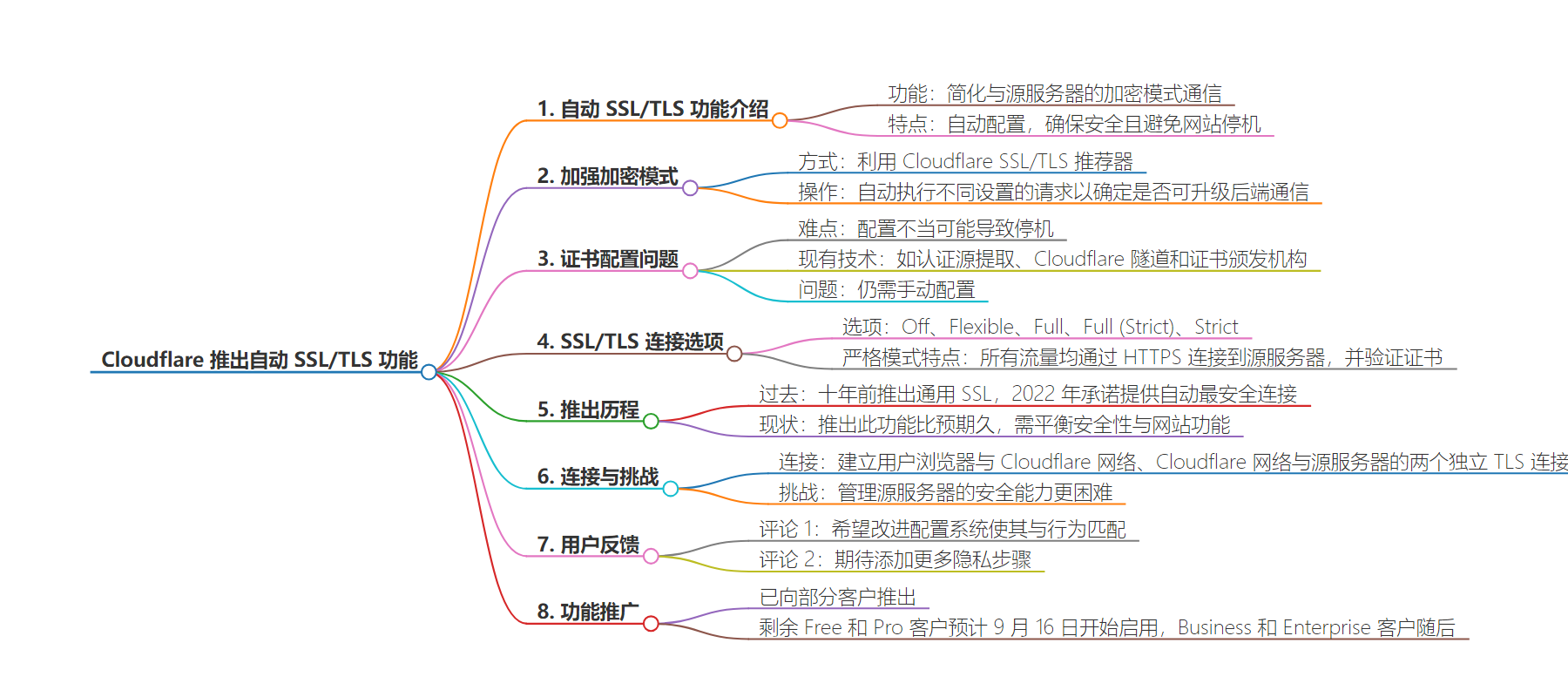包阅导读总结
1. `Cloudflare`、`Automatic SSL/TLS`、`Origin Server`、`Encryption Modes`、`Site Security`
2. Cloudflare 近期推出新的自动 SSL/TLS 设置,简化与源服务器的加密模式通信,确保安全且避免网站宕机,虽推出时间长于预期,但平衡了安全性与功能,已开始向部分客户推出。
3.
– Cloudflare 推出新的自动 SSL/TLS 设置
– 用于简化与源服务器的加密模式通信
– 自动配置,加强加密模式
– 利用 SSL/TLS 推荐器确定能否升级后端通信配置
– 重要性及相关问题
– 确保源服务器证书配置正确至关重要,错误配置可能导致宕机
– 虽已有多种相关技术,但仍需手动配置
– 提供五种 SSL/TLS 连接选项,严格模式下会验证源服务器证书
– 推出时间与用户反馈
– 推出时间长于预期,以平衡安全与功能
– 部分用户讨论相关技术的可用性和配置问题
– 已向部分客户推出,其余客户将陆续启用
思维导图:
文章来源:infoq.com
作者:Renato Losio
发布时间:2024/8/31 0:00
语言:英文
总字数:535字
预计阅读时间:3分钟
评分:91分
标签:Cloudflare,SSL/TLS,网络安全,云服务,自动化
以下为原文内容
本内容来源于用户推荐转载,旨在分享知识与观点,如有侵权请联系删除 联系邮箱 media@ilingban.com
Cloudflare recently introduced new Automatic SSL/TLS settings to simplify the provider’s encryption modes for communication with origin servers. This feature offers automatic configuration, ensuring security without risking site downtime.
Automatic SSL/TLS strengthens the encryption modes between Cloudflare and origin servers by utilizing the Cloudflare SSL/TLS Recommender. This recommender automatically performs a series of requests from Cloudflare to the customer’s origin(s) with different SSL/TLS settings to determine if the backend communication can be upgraded beyond the current configuration. Alex Krivit, product manager at Cloudflare, Suleman Ahmad, software research engineer at Cloudflare, J Evans, software engineer at Cloudflare, and Yawar Jamal, system engineer at Cloudflare, explain why this feature is important:
Ensuring certificates are configured appropriately on origin servers and informing Cloudflare about how we should communicate with origins can be anxiety-inducing because misconfiguration can lead to downtime if something isn’t deployed or configured correctly.
While Cloudflare already offers various technologies—such as Authenticated Origin Pulls, Cloudflare Tunnels, and a certificate authority—to help customers configure communication with origin servers, these options still require manual configuration changes both on the origin server and within Cloudflare settings.
/filters:no_upscale()/news/2024/08/cloudflare-automatic-ssl-origin/en/resources/1image3-1-1724503479236.png)
Source: Cloudflare Blog
Cloudflare provides five options for SSL/TLS connections with origin servers: Off, Flexible, Full, Full (Strict), and Strict. In the Strict mode, all traffic from the browser to Cloudflare, whether HTTP or HTTPS, will always be connected to the origin over HTTPS, with the origin server’s certificate being validated.
Cloudflare introduced Universal SSL a decade ago and, in 2022, pledged to provide customers with “the most secure connection from Cloudflare to their origin servers automatically,” while explaining the challenges of configuring origin SSL at scale. The provider now acknowledges that rolling out this feature took longer than anticipated. Krivit, Ahmad, Evans, and Jamal add:
Taking this additional time allowed us to balance enhanced security with seamless site functionality, especially since origin server security configuration and capabilities are beyond Cloudflare’s direct control.
Because Cloudflare acts as an intermediary between the client and the customer’s origin server, two separate TLS connections are established: one between the user’s browser and the Cloudflare network, and another between the Cloudflare network and the origin server. Unlike securing connections between clients and Cloudflare, managing the security capabilities of origin servers is more challenging. In a popular Hacker News thread, user amluto comments:
Cloudflare is talking about the security benefits of Cloudflare Tunnels. They may well be fairly secure, but I would love to see Cloudflare clean up their configuration system so that the configuration actually matches the behavior. Setting up a mapping from DNS name to route should not be called DNS and should absolutely not pretend to be a CNAME.
Other users discuss the usability of the Zero Trust portal and express concerns about the growing number of available options. User LinuxBender adds:
Since this takes human operations out of the loop on the origin for certs I could see an opportunity to add one more privacy step until Encrypted Client Hello (ECH) is universally supported on all the things.
The cloud provider has already begun rolling out the feature to customers with SSL/TLS Recommender enabled. Remaining Free and Pro customers are expected to be enrolled starting September 16th, with Business and Enterprise customers to follow.
